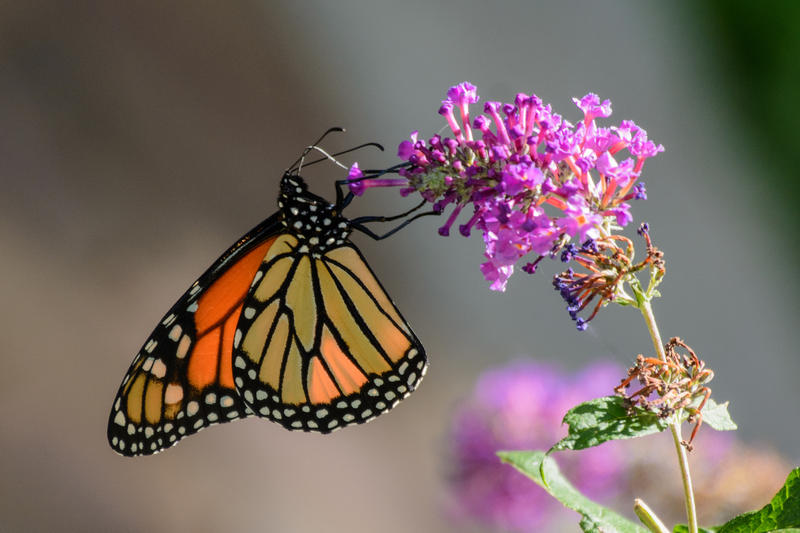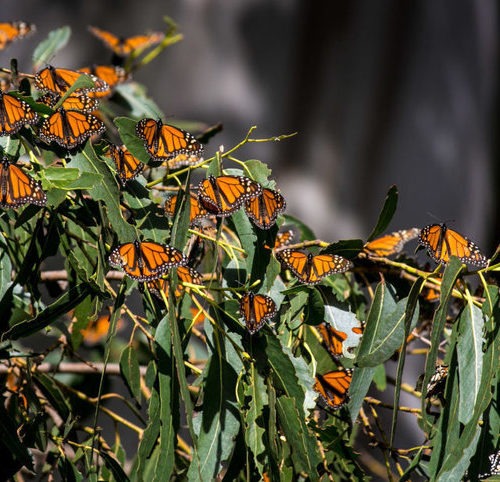
Monarch Butterflies Are Disappearing, But They May Be Saved, Researchers Say
Listen
NOTE: This article was originally published November 15, 2017.
The western monarch butterfly is disappearing.
With its distinct orange-and-black wings, the monarch is one of America’s best-known butterflies. But for the past few decades, their numbers have dropped, threatened by climate change, pesticides and habitat loss.
The decline can be seen most dramatically in California. Each year, monarch butterflies migrate there in great numbers. It’s one of the most dramatic migrations in the insect world, along with an even larger monarch butterfly migration to Mexico. They’re a major tourist attraction. By the 1990s, people began noticing a decline.
There used to be between 3 and 30 million western monarchs observed annually in California. Populations could vary for many reasons, but Schultz says they averaged about 10 million each year.
“It’s a lot more than what see now, which is about 300,000.” says Tufts University professor Elizabeth Crone. “Is a population of only 300,000 monarchs likely to persist into the future? The answer is no.”
Their unusual migration, which spans generations of butterflies, makes them a useful indicator of ecosystem health. They rely heavily on milkweed, the only plant on which they lay eggs, and are food for some birds and invertebrate predators. A decline means something has changed in the ecosystem, and could have a wider impact.
The Xerces Society, a conservation group, estimates a 74 percent population drop for butterflies that overwinter in California, and an 80 percent decline for Mexico-wintering eastern monarchs, a separate group of the same species.
Crone and Schultz worked together to develop that count of western monarchs. Their next step is to get a closer look at what is threatening them — and how they might be saved.
RECOVERY
Clues to the monarch’s recovery may lie with a small butterfly from Oregon called the Fender’s blue, which Crone and Schultz have studied for 20 years.
Like the monarch, Fender’s blue butterflies only lay eggs in specific plants. But they’re even choosier. Fender’s will only lay eggs on the Kincaid’s lupine. That plant is listed as threatened by the Oregon Department of Fish and Wildlife, which lists the Fender’s blue as endangered.
But in 2010, Oregon began a recovery plan. The state worked with landowners to protect the Fender’s blue habitat, such as farmers and homeowners to grow plants that feed pollinators, rather than cut them down — something Washington and other states have done to protect honey bees.
The recovery effort has worked. Schultz says the population of Fender’s blue butterflies has gone from 1,500 to more than 28,000 over the last two decades. Schultz believes similar efforts may help restore monarch populations.
In the meantime, biologists have petitioned to have monarchs listed as a threatened or endangered species.
The U.S. Fish and Wildlife service is currently assessing whether to give the monarch butterfly protection under the Endangered Species Act.
Copyright 2017 Northwest Public Broadcasting
Related Stories:

‘It’s Just So Fantastic’: Wolverine Family Seen At Mount Rainier, No Signs Yet Of Cyclops Or Beast
Conservationists are “cautiously optimistic” after discovering a mother wolverine and her kits at Mount Rainier National Park. It’s the first time a family of wolverines has called the park home in more than 100 years.

2020 Brings New Protections For West Coast Seafloor Habitat
Regulations that began Jan. 1 restrict bottom trawl fishing on about 90% of the seafloor off Washington, Oregon and California.

Monarch Butterflies Born In Captivity Have Trouble Migrating South, Study Says
The monarch population has declined more than 80% in the past 20 years, and the U.S. Fish and Wildlife Service is considering them for the endangered species list. Hobbyists and educators have responded by raising and releasing butterflies. But there are issues, they say, with releasing captive, potentially nonmigratory butterflies into the wild population.















